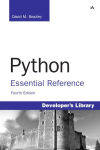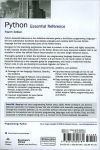Designed for the professional programmer, the book is concise, to the point, and highly accessible. It also includes detailed information on the Python library and many advanced subjects that is not available in either the official Python documentation or any other single reference source.
Thoroughly updated to reflect the significant new programming language features and library modules that have been introduced in Python 2.6 and Python 3, the fourth edition of Python Essential Reference is the definitive guide for programmers who need to modernize existing Python code or who are planning an eventual migration to Python 3. Programmers starting a new Python project will find detailed coverage of contemporary Python programming idioms.
This fourth edition of Python Essential Reference features numerous improvements, additions, and updates:
- Coverage of new language features, libraries, and modules
- Practical coverage of Python's more advanced features including generators, coroutines, closures, metaclasses, and decorators
- Expanded coverage of library modules related to concurrent programming including threads, subprocesses, and the new multiprocessing module
- Up-to-the-minute coverage of how to use Python 2.6’s forward compatibility mode to evaluate code for Python 3 compatibility
- Improved organization for even faster answers and better usability
- Updates to reflect modern Python programming style and idioms
- Updated and improved example code
- Deep coverage of low-level system and networking library modules — including options not covered in the standard documentation
Designed for the professional programmer, the book is concise, to the point, and highly accessible. It also includes detailed information on the Python library and many advanced subjects that is not available in either the official Python documentation or any other single reference source.
Thoroughly updated to reflect the significant new programming language features and library modules that have been introduced in Python 2.6 and Python 3, the fourth edition of Python Essential Reference is the definitive guide for programmers who need to modernize existing Python code or who are planning an eventual migration to Python 3. Programmers starting a new Python project will find detailed coverage of contemporary Python programming idioms.
This fourth edition of Python Essential Reference features numerous improvements, additions, and updates:
- Coverage of new language features, libraries, and modules
- Practical coverage of Python's more advanced features including generators, coroutines, closures, metaclasses, and decorators
- Expanded coverage of library modules related to concurrent programming including threads, subprocesses, and the new multiprocessing module
- Up-to-the-minute coverage of how to use Python 2.6’s forward compatibility mode to evaluate code for Python 3 compatibility
- Improved organization for even faster answers and better usability
- Updates to reflect modern Python programming style and idioms
- Updated and improved example code
- Deep coverage of low-level system and networking library modules — including options not covered in the standard documentation

Python Essential Reference
752
Python Essential Reference
752Paperback(Fourth)

Product Details
| ISBN-13: | 9780672329784 |
|---|---|
| Publisher: | Pearson Education |
| Publication date: | 07/09/2009 |
| Series: | Developer's Library |
| Edition description: | Fourth |
| Pages: | 752 |
| Product dimensions: | 5.90(w) x 8.90(h) x 1.10(d) |



